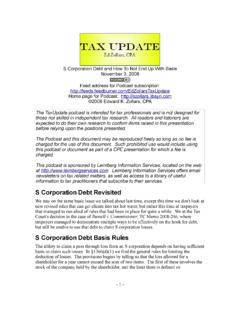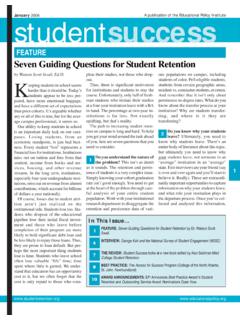Transcription of The Clash of the Cultures - John C. Bogle
1 The Clash of the Cultures JOHN C. Bogle JOHN C. Bogle is the founder ofThe Vanguard Group in Valley Forge, PA. D uringthe recent era, major changes have taken place in our nation's financial sector. They reflect two very different Cultures that have existed in the world of capital formation and capital markets all through history. But today's model of capitalism has lost the optimal bal ance between these two Cultures , to the detri ment of the investing public-indeed to the ultimate detrinlent of our society-and to the benefit of financial sector participants at the direct, arguably dollar-for-dollar, expense oftheir clients. As a member of the fmanciaI commu- nity, I'm concerned about these changes. 1'm also concerned as a menlber ofthe community ofinvestors, and as a citizen oErhis nation.
2 The issue that concerns me is, simply put, today's ascendance ofspeculation over investment in our financial nlJrkets; or, ifyou will, the ascen dance of the culture of science-of instant measurement and quantification--over the culture of the humanities-of steady reason and rationality. Hence my title, the phrase popularized by the British author Snow a half-century ago: "The Clash of the Cul ttues." As I see it, long-term investing reflects the culture ofthe intellectual, the philosopher, and the historian, and short-term speculation reflects the culture ofthe statistician, the tech nician, and the alcheInist. Such a criticism might seem to fly in the face ofour evernlOre scientific and technological world, overwhelnled today with innovation, information, instant communications, and competition that have brought great benefits to our society.
3 But I see our financial system as somehow separate and distinct from the other business and commercial systems that permeate our world. There is a difference-a difference in kind--between what economists describe as "rem-seeking" activities that, on balance, sub tract value from society and "value-creating" activities that add value to society, providing new and improved products and services at ever more efficient prices. But, on balance, tech nology has done little to improve the lot of investors during the recent era. Pressed to iden tify useful financial innovations, Paul Volcker, recent chairman of the President's Economic Recovery Board, singled out only "the ATM as his favorite financial innovation ofthe past 25 years" (W5J [2009]).
4 When applied to the physical world. to state the obvious, scientific techniques have been successfully used to determine cause and effect, helping us to predict and control our environment. This success has encour aged the idea that scientific techniques can be productively applied to all human endeavors, including investing. But investing is not a sci ence. It is a human activity that involves both emotional as well as rational behavior. Finan cial markets are far too complex to isolate any single variable with ease, and the record is utterly bereft of evidence that definitive 14 THf. CLt\:'iH Of THE SPRING 2011 predictions ofshort-term fluctuations in stock prices can be made with consistent accuracy. The prices ofcommon stocks are evanescent and illusory, for equity shares are themselves merely derivatives-think about that!
5 -ofthe returns created by our publicly held corporations and the vast and productive investments in physical capital and human capital that they represent. Intelligent investors try to separate their emotions ofhope, fear, and greed that separate the volatile market ofshort-term expectations from the real market oflong term intrinsic value, and trust in reason to prevail over the long term. In this sense, long-term investors must be philosophers rather than technicians. This differ ence suggests one of the great paradoxes of the finan cial sector of today's economy: Even as it becomes increasingly clear that a strategy of staying the course is far more productive than market timing or the ulti mate futility of hopping from one stock-or one stock fund-to another, our financial institutions, through modern information and comnlUnications technology, make it increasingly easy for their clients and share holders to engage in frequent and rapid movement of their investment assets.
6 THE RISE OF SPECULATION The extent of this step-up in speculation-a word I've chosen as a proxy for rapid trading offinan cial instruments of all types-can be easily measured. Let's begin with stocks. Annual turnover stocks (trading volume as a percentage of marketable shares outstanding) was about 15% when I entered this business in 1951, right out of college. Over the next 15 years, turnover averaged about 35%. By the late 1990s, it had gradually increased to the 100% range, and hit 150% in 2005. In 200S, stock turnover soared to the remark able level ofsome 2S0% aud declined modestly to some 250% in 2010.' Think about the numbers. When I into this field, stock trading volumes averaged about 2 million shares per day.
7 Today we trade about Sy, billion shares ofstock daily. Annualized, the total comes to n10re than 2 trillion shares-in dollar terms, I estimate some $40 trillion. That figure, iu turn, is 300% ofthe $13 trillion market capitalization stocks. To be sure, some of those purchases and sales are made by long-term investors. But even if we look at what are considered long-term investors, precious few measure up to that designation. SPRING 2011 In the rnutual fund industry, for exan1ple, the annual rate of portfolio turnover for the average actively man aged equity fund runs to almost 100%, ranging from a hardly minimal 25% for the lowest turnover quiutile to an astonishing 230% for the highest quiutile2 The stock market turnover numbers include enor mous trading through today's high-frequeucy traders (HFTs), who are said to coustitute some 50% of the total.
8 These HFTs, in fairness, stand ready to pro vide liquidity to market participants, a valuable ser vice offered for just penuies per share, with holding periods for their positions as short as 16 seconds. Yes, 16 seconds. (This multiple market system, however, has created significant inequities in order execution that demaud a regulatory response.) The high demand for the services ofHFTs comes not only from "punters" sheer gamblers who thrive (or hope to thrive) by bet ting against the bookmakers-but from other diverse sources ranging from longer-terul investors who value the liquidity and efficiency of HFTs, to hedge fuud managers who act with great speed based on perceived stock mispricings that may last only momentarily.
9 This aspect of "price discovery" clearly enhances market efficiency, a definite benefit even to investors with a long-term focus. Considernow how these tens oftrillions ofdollars of transaction activity in the secondary market each year with transaction activity in the primary market. Providing fresh capital to business-let's call it capital formation-was once accepted as the principal eco nomic mission ofWall Street. The process ofallocatiug investment capital to the most promising industries and companies, both those that seek to provide better and better goods and services at increasingly econornic prices to consumers and businesses, and innovators that seek to do the same, ouly faster. How large is that capital forma tion activity?
10 Let's begin with stocks. Total equity IPOs have averaged about $35 billion annually over the past decade, and secondary offerings have averaged about $110 billion, bringing uew issues of common stock to some $145 billion.' So today's annual stock trading volume of$30 trillion is now some 200 times the volume ofequity capital provided to businesses. That is a sizable imbalance. I'm not sure where to put debt issuance in this comparison. For the record, debt issuance over the past decade averaged about $ trillion auuually, fully $1 trillion of which was accounted for by the now THE JOURNAL OF MANA~ 15 virtually defunct area of asset-backed debt and mort gage-backed debt, too often based on fraudulent lending and phony figures that were willingly accepted by our rating agencies, witting co-conspirators in handing out AAA ratings to debt securities that would soon tumble in the recent debacle, their ratings finally slashed.



